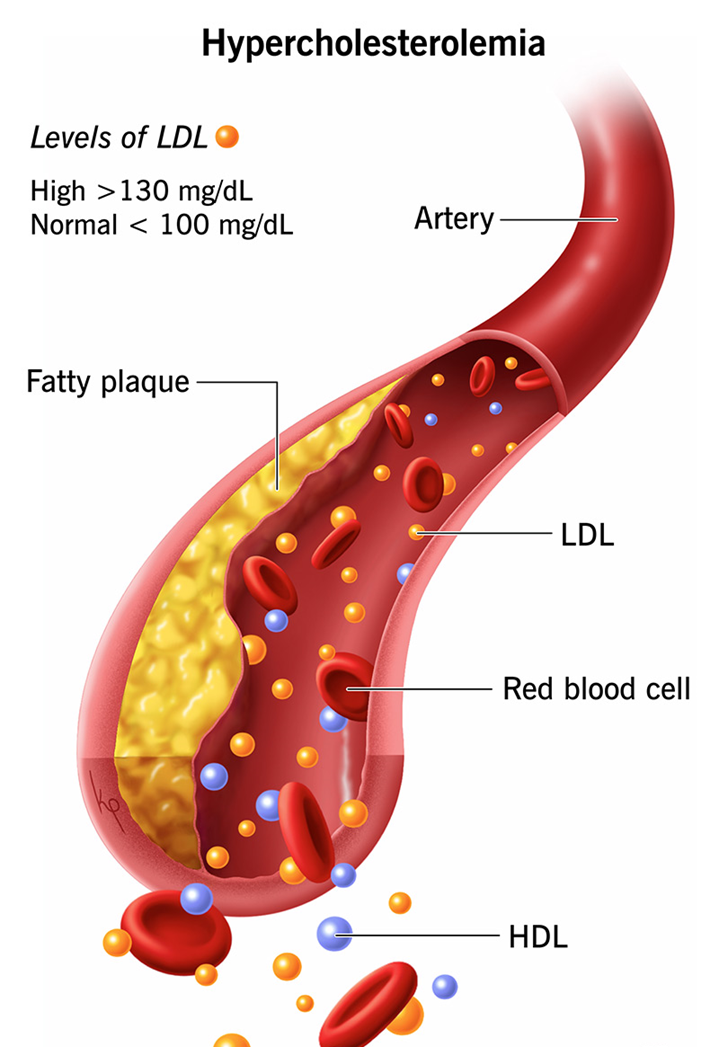A nurse is assessing a client who has hypercholesterolemia and is receiving simvastatin. Which of the following findings should the nurse recognize as a potential adverse effect?
Blurred vision
Orthostatic hypotension
Urinary retention
Muscle weakness
The Correct Answer is D
Choice A reason: Blurred vision is not a common or serious side effect of simvastatin, as it does not affect the eyes or the vision. Blurred vision may be caused by other factors, such as diabetes, hypertension, or eye disorders.
Choice B reason: Orthostatic hypotension is not a common or serious side effect of simvastatin, as it does not affect the blood pressure or the vascular tone. Orthostatic hypotension may be caused by other factors, such as dehydration, anemia, or medication interactions.
Choice C reason: Urinary retention is not a common or serious side effect of simvastatin, as it does not affect the urinary tract or the bladder function. Urinary retention may be caused by other factors, such as prostate enlargement, infection, or nerve damage.
Choice D reason: Muscle weakness is a common and serious side effect of simvastatin, as it can indicate muscle damage or rhabdomyolysis. Rhabdomyolysis is a life-threatening condition that causes the breakdown of muscle tissue and the release of myoglobin into the bloodstream, which can lead to kidney failure. Muscle weakness may be accompanied by muscle pain, tenderness, or dark urine. The nurse should monitor the client's creatine kinase (CK) levels and report any signs of muscle damage to the provider.

Nursing Test Bank
Naxlex Comprehensive Predictor Exams
Related Questions
Correct Answer is B
Explanation
Choice A reason: Taking the medication in the morning is not the correct instruction. Simvastatin is a statin drug that lowers cholesterol levels by inhibiting the enzyme that produces cholesterol in the liver. The liver produces more cholesterol at night, so simvastatin is more effective when taken in the evening or at bedtime.
Choice B reason: Avoiding grapefruit juice is the correct instruction. Grapefruit juice can increase the blood levels of simvastatin and cause serious side effects such as muscle damage, liver damage, and kidney failure. Grapefruit juice inhibits the enzyme that metabolizes simvastatin in the intestine, leading to higher concentrations of the drug in the bloodstream.

Choice C reason: Monitoring for ringing in the ears is not the correct instruction. Ringing in the ears, or tinnitus, is not a common or serious side effect of simvastatin. However, some other medications that lower cholesterol, such as niacin and gemfibrozil, can cause tinnitus. The client should report any unusual or persistent symptoms to the prescriber.
Choice D reason: Expecting brown-colored urine is not the correct instruction. Brown-colored urine, or hematuria, is not a normal or expected side effect of simvastatin. However, it may indicate a serious condition such as rhabdomyolysis, which is a rare but life-threatening complication of statin therapy. Rhabdomyolysis is the breakdown of muscle tissue that releases a protein called myoglobin into the bloodstream. Myoglobin can damage the kidneys and cause brown-colored urine. The client should seek immediate medical attention if they notice any signs of rhabdomyolysis, such as muscle pain, weakness, fever, or dark urine.
Correct Answer is A
Explanation
Choice A reason: Infection is the correct condition that the client is at increased risk for. Agranulocytosis is a severe decrease in the number of granulocytes, which are a type of white blood cell that fight infection. Propylthiouracil is an antithyroid drug that can cause agranulocytosis as a rare but serious side effect. The client with agranulocytosis is more susceptible to bacterial and fungal infections, and may present with fever, sore throat, mouth ulcers, and skin lesions.
Choice B reason: Excessive bleeding is not the correct condition that the client is at increased risk for. Agranulocytosis does not affect the platelets, which are the blood cells that help with clotting. Propylthiouracil does not cause bleeding disorders, although it may interact with anticoagulants and increase their effect.
Choice C reason: Hyperglycemia is not the correct condition that the client is at increased risk for. Agranulocytosis does not affect the insulin, which is the hormone that regulates blood glucose levels. Propylthiouracil does not cause hyperglycemia, although it may interfere with the metabolism of oral hypoglycemic agents and decrease their effect.
Choice D reason: Ecchymosis is not the correct condition that the client is at increased risk for. Ecchymosis is a bruise caused by bleeding under the skin. Agranulocytosis does not cause ecchymosis, as it does not affect the blood vessels or the platelets. Propylthiouracil does not cause ecchymosis, although it may increase the risk of skin rash and pruritus.
Whether you are a student looking to ace your exams or a practicing nurse seeking to enhance your expertise , our nursing education contents will empower you with the confidence and competence to make a difference in the lives of patients and become a respected leader in the healthcare field.
Visit Naxlex, invest in your future and unlock endless possibilities with our unparalleled nursing education contents today
Report Wrong Answer on the Current Question
Do you disagree with the answer? If yes, what is your expected answer? Explain.
Kindly be descriptive with the issue you are facing.
